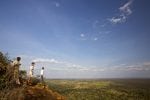Meru National Park is one of the most beautiful in Africa, and in addition to being home to lions, cheetahs, elephants and rhinos, the park is known for its diversity of nature and wildlife, including the rare kudu antelope. Your guide can show you all the national park’s secret places and great experiences: from the springs with palm trees to the sand formations by the river Tana. A paradise for ornithologists is also with over 450 bird species to keep an eye on. The park also grows several giant baobab trees, a tree that can be over 1,000 years old. This trip gives you great experiences, and also helps the local community and the local nature.
Contact form

Ecorating: 4.0
This product meets our requirements for Ecorating, a product that is good for humans and the environment.
Does my trip make a difference?
Read more
This product meets our requirements for Ecorating, a product that is good for humans and the environment.
Sample Itinerary

Upon arrival in Nairobi and Jomo Kenyatta International Airport, you will be greeted by one of our representatives who will make sure that you arrive at your accommodation hotel. Bed and breakfast.

After an early breakfast at the hotel, you will meet your guide, who will be your regular companion throughout the journey. You set off in a 4×4 jeep and an exciting journey starts through different landscapes, you reach up to 2,700 meters altitude and later down to approx. 1,000 feet above sea level with the most beautiful views of the Great Rift Valley. Breakfast at Barney’s Restaurant in Nanyuki. After lunch on to Meru and finally arrival at Elsas Kopje late in the afternoon. Your stay at Elsas Kopje will include activities such as guided bush walks, bush meals, visits to local schools and community projects, fishing in the rivers Tana or Rojewero, there will also be plenty of time to enjoy a relaxing massage, relax by the pool or enjoy a sundowner or cold beer.

At Elsas Kopje there are several different types of accommodation options: choose between your own holiday home, a honeymoon suite or a family suite.

Experience nature and the landscape together with your guide in the beautiful nature.

It is possible to have a private dinner by the pool in the evening.
Trip details
Good to know about Kenya & Masai Mara: Meru National Park is located east of Meru, 350 km from Nairobi. The area covers a full 870 km² and is one of the most famous national parks in Kanya. Here comes a lot of rain, which ultimately means lots of lush grass and a lot of swamp areas. The park is home to many wildlife including the African bush elephant, the East African lion, African leopard, Kenyan cheetah, black and white rhino, zebra and hippopotamus.
Good to remember: In the Masai Mara, water is in short supply, so drink and use it with care and respect. The Masai are a proud people, always ask before you photograph. Bring notes in smaller denominations to be able to buy local crafts and the like in the small communities. How to greet the people you meet? In the same way that we in the Western world do – you take hands.
Mobile coverage and internet: The hotel has internet and mobile coverage is good. However, it is a wish of the management that you prefer to turn off the mobile, or use it discreetly.
Time zone: GMT + 3
Vaccinations: Read more about which vaccinations to use, for example hereStatens Serum Institut
Packing: On safaris in the Masai Mara you are often 1,300 – 1,500 meters above sea level, and both in the morning, in the evening and at night it can be quite cold. Bring a good sweater and windbreaker, good shoes for walking in
Bring a small backpack to be able to bring water, binoculars, camera or other personal belongings on the excursions. We recommend soft rather than hard travel bags – they are easier to transport along the way, so a backpack or similar is a good choice. Mosquito nets are available on site, but feel free to bring mosquito spray or similar.
Local currency: Kenyan Shilling
Observer: Kenya has banned plastic bags and this is checked by customs. If you bring a plastic bag, this can mean a fine.
Weather right now: Weather Masai Mara
Water: Clean water is available in the camp.
Security: The Masai Mara is an extremely safe area. In the capital Nairobi, however, do not go alone in some places – this is especially true in the city center.
More information can be found hereRejsevejledninger på um.dk
Travel entry requirements: : All travelers to Kenya must apply for and be approved for an Electronic Travel Authorization (eTA) to visit the country. Click on the link below and follow their instructions (Applicants should have their passport and travel information and payment card ready). The price is 35 USD per person including children. If you are a family traveling, you can apply together. Apply no later than 3 weeks before departure. Se mer här: Electronic Travel Authorisation (eTA)

Ecorating: 4.0
This product meets our requirements for Ecorating, a product that is good for humans and the environment.
Does my trip make a difference?
Read more
This product meets our requirements for Ecorating, a product that is good for humans and the environment.
Challenges – a bit about history
This was an extremely popular safari area through the sixties and seventies, but perhaps you did not have the same focus on sustainability and how you treated wildlife at the time. In the eighties and nineties, people were plagued by a lot of poaching, and here a large part of the area’s elephants and rhinos disappeared. When the animals were gone, the tourists also disappeared and many believed that the country’s government would close the park.
But the couple Stefano & Liz Cheli wanted something different. They wanted to build a new lodge in the park to secure the park’s future, and started negotiations with the authorities and KWS in 1993, something which four years later ended with an OK for the project. The lodge was ready in 1999, and since then has experienced a steadily increasing number of guests: from 3,500 in 1999 to 15,200 10 years later. Elsas Kopje supports Kenya Wildlife Service (KWS) through the leasing of the lodge’s area and the entrance fees paid by visitors. With this money, KWS has improved the infrastructure, among other things by setting up better fences, and over 1,300 animals have been brought to the park. Animals that were otherwise almost away from the park: various giraffes, Grevy Zebra, leopard and elephant. More than 450 different species of birds now live here.
KWS has had a special focus on the area’s rhinos, and in 2003 20,750 barrels of land were set aside as a protected area for over 70 white and black rhinos.
Elsa’s Kopje has undoubtedly been a positive force in this work, and an important part of the fact that Meru National Park is once again full of life and with increasing biodiversity.
Responsible Tourism
Elsa Kopje has been awarded the “Gold Level” from Kenya’s ecotourism organization, and in 2016 she received the “Silver Level” from Sustainable Tourism International – an international award.
The lodge consumes a minimum of energy. They have invested in LED lighting and other low-energy lamps, there is a photovoltaic system so that you do not have to use the generator as much – usually it now only runs for a few hours a day. To limit CO2 emissions, buy as many raw materials as possible from local producers. Wood used for repairs or new construction comes from local forests, which are grown in a responsible and long-term way.
Waste is sorted and recycled as much as possible. All glass is sent for recycling, including at “Central Glass” in Nairobi.





